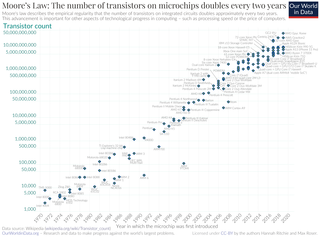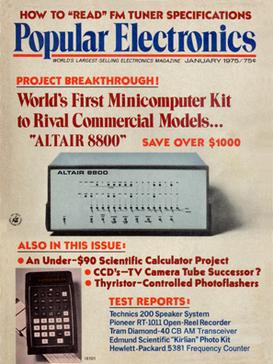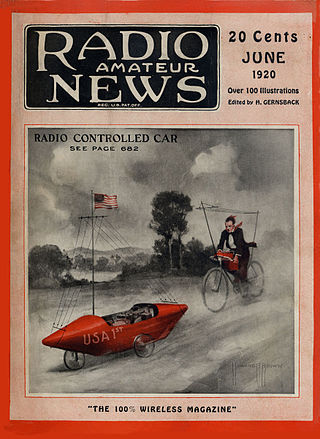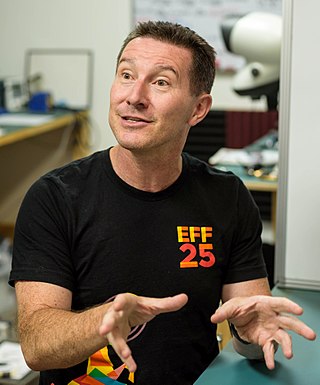Related Research Articles

Electrical engineering is an engineering discipline concerned with the study, design, and application of equipment, devices, and systems that use electricity, electronics, and electromagnetism. It emerged as an identifiable occupation in the latter half of the 19th century after the commercialization of the electric telegraph, the telephone, and electrical power generation, distribution, and use.

Electronics is a scientific and engineering discipline that studies and applies the principles of physics to design, create, and operate devices that manipulate electrons and other electrically charged particles. It is a subfield of physics and electrical engineering which uses active devices such as transistors, diodes, and integrated circuits to control and amplify the flow of electric current and to convert it from one form to another, such as from alternating current (AC) to direct current (DC) or from analog signals to digital signals.

An integrated circuit (IC), also known as a microchip, computer chip, or simply chip, is a small electronic device made up of multiple interconnected electronic components such as transistors, resistors, and capacitors. These components are etched onto a small piece of semiconductor material, usually silicon. Integrated circuits are used in a wide range of electronic devices, including computers, smartphones, and televisions, to perform various functions such as processing and storing information. They have greatly impacted the field of electronics by enabling device miniaturization and enhanced functionality.

The 6800 is an 8-bit microprocessor designed and first manufactured by Motorola in 1974. The MC6800 microprocessor was part of the M6800 Microcomputer System that also included serial and parallel interface ICs, RAM, ROM and other support chips. A significant design feature was that the M6800 family of ICs required only a single five-volt power supply at a time when most other microprocessors required three voltages. The M6800 Microcomputer System was announced in March 1974 and was in full production by the end of that year.

Moore's law is the observation that the number of transistors in an integrated circuit (IC) doubles about every two years. Moore's law is an observation and projection of a historical trend. Rather than a law of physics, it is an empirical relationship. It is an experience-curve law, a type of law quantifying efficiency gains from experience in production.
Silicon on sapphire (SOS) is a hetero-epitaxial process for metal–oxide–semiconductor (MOS) integrated circuit (IC) manufacturing that consists of a thin layer of silicon grown on a sapphire wafer. SOS is part of the silicon-on-insulator (SOI) family of CMOS technologies.

Fry's Electronics was an American big-box store chain. It was headquartered in San Jose, California, in Silicon Valley. Fry's retailed software, consumer electronics, household appliances, cosmetics, tools, toys, accessories, magazines, technical books, snack foods, electronic components, and computer hardware. Fry's had in-store computer repair and custom computer building services.

Popular Electronics was an American magazine published by John August Media, LLC, and hosted at TechnicaCuriosa.com. The magazine was started by Ziff-Davis Publishing Company in October 1954 for electronics hobbyists and experimenters. It soon became the "World's Largest-Selling Electronics Magazine". In April 1957, Ziff-Davis reported an average net paid circulation of 240,151 copies. Popular Electronics was published until October 1982 when, in November 1982, Ziff-Davis launched a successor magazine, Computers & Electronics. During its last year of publication by Ziff-Davis, Popular Electronics reported an average monthly circulation of 409,344 copies. The title was sold to Gernsback Publications, and their Hands-On Electronics magazine was renamed to Popular Electronics in February 1989, and published until December 1999. The Popular Electronics trademark was then acquired by John August Media, who revived the magazine, the digital edition of which is hosted at TechnicaCuriosa.com, along with sister titles, Mechanix Illustrated and Popular Astronomy.
Silicon Chip is an Australian electronics magazine. It was started in November, 1987 by Leo Simpson. Following the demise of Electronics Australia, for many years it was the only hobbyist-related electronics magazine remaining in Australia. A new competitor, called Diyode launched in July 2017.
Qterics is a company which has developed a system for datacasting firmware upgrades to digital television devices. It appears that UpdateTV is the only product the company, founded in 2003, has yet developed.
Electronics Today International or ETI was a magazine for electronics hobbyists and professionals.

Radio News was an American monthly technology magazine published from 1919 to 1971. The magazine was started by Hugo Gernsback as a magazine for amateur radio enthusiasts, but it evolved to cover all the technical aspects to radio and electronics. In 1929, a bankruptcy forced the sale of Gernsback's publishing company to B. A. Mackinnon. In 1938, Ziff-Davis Publishing acquired the magazines.
A transistor is a semiconductor device with at least three terminals for connection to an electric circuit. In the common case, the third terminal controls the flow of current between the other two terminals. This can be used for amplification, as in the case of a radio receiver, or for rapid switching, as in the case of digital circuits. The transistor replaced the vacuum-tube triode, also called a (thermionic) valve, which was much larger in size and used significantly more power to operate. The first transistor was successfully demonstrated on December 23, 1947, at Bell Laboratories in Murray Hill, New Jersey. Bell Labs was the research arm of American Telephone and Telegraph (AT&T). The three individuals credited with the invention of the transistor were William Shockley, John Bardeen and Walter Brattain. The introduction of the transistor is often considered one of the most important inventions in history.

The TEC-1 is a single-board kit computer first produced by the Australian hobbyist electronics magazine Talking Electronics in the early 1980s. The design by John Hardy and Ken Stone was based on the Zilog Z80 CPU, had 2K of RAM and 2K of ROM in a default configuration. Later versions used a 4k ROM with two different versions of the monitor software selectable via a switch. This allowed the early software presented in the magazine to be used with the later version of the TEC-1.

Radio-Electronics was an American electronics magazine that was published under various titles from 1929 to 2003. Hugo Gernsback, sometimes called the father of science fiction, started it as Radio-Craft in July 1929. The title was changed to Radio-Electronics in October 1948 and again to Electronics Now in July 1992. In January 2000 it was merged with Gernsback's Popular Electronics to become Poptronics. Gernsback Publications ceased operations in December 2002 and the January 2003 issue was the last. Over the years, Radio-Electronics featured audio, radio, television and computer technology. The most notable articles were the TV Typewriter and the Mark-8 computer. These two issues are considered milestones in the home computer revolution.
Fun with Radio is a book by Gilbert Davey first published in 1957 by Edmund Ward Ltd (London).
This article details the history of electronics engineering. Chambers Twentieth Century Dictionary (1972) defines electronics as "The science and technology of the conduction of electricity in a vacuum, a gas, or a semiconductor, and devices based thereon".

David L. Jones is an Australian video blogger. He is the founder and host of EEVBlog, a blog and YouTube channel targeting electronics engineers, hobbyists, hackers, and makers. His content has been described as a combination of "in-depth equipment reviews and crazy antics".

Wireless Weekly was Australia's first news-stand wireless magazine, published in 1922 in Sydney by William John Foster St Clair Maclardy and his father William McIntyre St Clair Maclardy. W. J. Maclardy was one of the founders of the "A" Class radio station 2SB. It arose from conversations between Florence Violet (Vera) McKenzie OBE, aka 'Violet Wallace, 'Vera Wallace' and later 'Mrs Mac' (1890-1982), who owned a wireless shop in the Royal Arcade, Sydney, Ron Marsden her engineer, and Maclardy. The front cover featured a photo of amateur radio activity.
References
- ↑ Electronics Australia projects and circuits. National Library of Australia. Retrieved 30 October 2016.
- ↑ Jones, David. "Electronics Australia Today (EAT)". David L. Jones. Retrieved 27 December 2012.
- ↑ Jones, David (28 December 2012). "EA Front Cover Images". EEVblog. Retrieved 29 December 2012.
- ↑ "aus.electronics EAT Refund Discussion". aus.electronics. Retrieved 27 December 2012.
- ↑ Yates, Darren. "aus.electronics EAT discussion". aus.electronics. Retrieved 27 December 2012.
- ↑ Simpson, Leo. "Interview with Leo Simpson". EEVblog. Archived from the original on 12 December 2021. Retrieved 27 December 2012.
- ↑ "About Silicon Chip". Silicon Chip. Retrieved 27 December 2012.